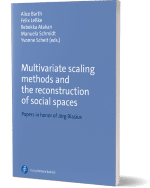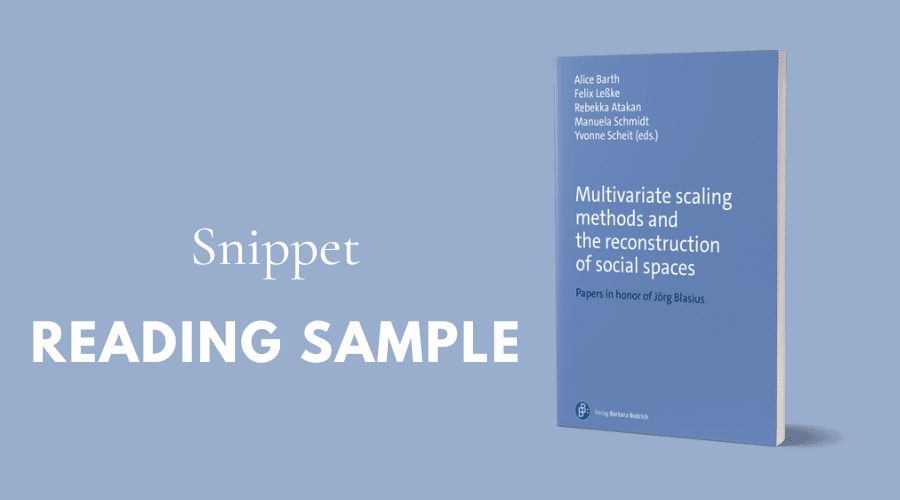Multivariate scaling methods and the reconstruction of social spaces. Papers in honor of Jörg Blasius (open access)
edited by Alice Barth, Felix Leßke, Rebekka Atakan, Manuela Schmidt and Yvonne Scheit
About the book
This edited volume assembles contributions of leading scholars in the fields of statistical methods and applications in the social sciences. Multivariate scaling methods for categorical data, in particular correspondence analysis, are used to extract the most important dimensions from complex data tables and to visualize relationships in the data. The volume treats recent statistical developments, methodological considerations, and empirical applications. A special emphasis is placed on multiple aspects of space and their sociological significance: the reconstruction of “social spaces” with statistical methods, illustrations of spatial relations involving proximity, distance and inequality, and concrete interactions in urban neighbourhoods.
Reading sample from pp.83-86
Religiosity and climate change beliefs in Europe
Martin Fritz & Yasemin El-Menouar
1. Introduction
In this chapter we investigate how religiosity and climate change beliefs are linked to each other. Why is this question relevant and worth studying? The answer is that religions are powerful social institutions which can and should play a crucial role in mobilizing society for the much-needed climate action. They can provide deeply rooted value foundations for a more ecologically sustainable mode of living and are able to reach out to great numbers of people. To tap this potential, it is important to understand the role of religion for human-nature relations and more specifically how different aspects of religiosity are connected to views on climate change.
Against the background of the increasing need and urgency of addressing climate change, most religions have taken official stances expressing their support for fast and far-reaching climate action. Probably most prominently in the Western world, the Laudato Si of Pope Francis (2015) addressed the topic, but there are similar statements or declarations in Islam and Buddhism, for example, as well as statements of interfaith organizations. While these pro-climate, pro-nature position-takings were declared at the level of institutions and led to a discussion about a potential ‘greening’ of religions (see 2.1), the question remains whether the adherents of religions share these views.
Previous empirical research which has investigated the links between religiosity and climate change beliefs, or more generally: views on nature, mainly focused on the US and other Anglo-Saxon countries, therefore analyzing primarily different Christian denominations. Applying methods of causal inference, these studies come to partly contradicting results: There are differences in the support for more climate and environmental protection between respondents of different religious denominations and between religious persons and non-believers. Some studies found Evangelicals to be least supportive; others show that Catholics are equally unconcerned about climate and ecological issues as Evangelicals. For the greening-of-religions hypothesis, only very little evidence is found in empirical research and there are indications that different aspects of religiosity such as attendance at religious services and praying have different effects on climate change beliefs. Also, interactions with other concepts like political ideology were shown. In short, the relationship between religiosity and climate change beliefs seems complex and largely remains unclear.
There is, however, a lack of quantitative research with a larger and different geographical focus than in existing studies. There is also a need for applying Correspondence Analyses and Related MEthods (CARME) to better explore the links between different aspects of religiosity and climate change beliefs without the methodological restrictions and assumptions that causal approaches have to deal with. This chapter presents a first attempt in closing this gap and proceeds as follows: We first discuss briefly how, on the one side, Judeo-Christian religions were criticized to promote human dominion over nature and an anthropocentric, dualist worldview and, on the other side, how researchers have argued about their recent greening (section 2.1). This is followed by a short overview on the existing studies on the relationship between religiosity and views on nature in general and climate change beliefs in particular (2.2). In section 3 we introduce our data, the European Social Survey, and our method, Multiple Correspondence Analysis, in more detail. The results, including graphical representations of the links between religiosity and climate change beliefs, are presented and discussed in section 4. Finally, we conclude the chapter with interpreting the results in light of religions’ potential to mobilize for climate action and point to some possibilities for future research.
2. Theoretical reflections and previous empirical research on the links between religiosity and climate change beliefs
2.1 Changing religious stances towards nature: from domination to conservation?
Religion, particularly Judeo-Christian traditions, has been criticized by scientists for promoting human domination over nature. A key article making this argument was published by White (1967). Long before climate change entered the area of public attention he recognized the geological scope of ecological problems and states that fossil fuels threaten “…to change the chemistry of the globe’s atmosphere as a whole, with consequences which we are only beginning to guess” (p. 1204). White argues that human relations to nature are “…deeply conditioned by beliefs about our nature and destiny – that is, by religion.” (p. 1205). He attributes ecological destruction to the specific Judeo-Christian story of creation in which God created man in God’s image and planned all the animals and plants for man’s benefit and rule. Being an anthropocentric religion in contrast to ancient paganism and Asian religions, it would have established a dualism of humans and nature and insists that it is God’s very will that humans exploit nature. Further, he demonstrates how this thinking has deeply shaped Western culture, economy and science and ultimately led to the ‘great acceleration’ of all kinds of human activities (Steffen et al. 2015) that today challenge us with multiple ecological crises.
Ecofeminist scholars also highlight that Western science, particularly in the tradition of Bacon, Hobbes and Descartes, facilitates controlling, manipulating and exploiting nature. These thinkers claimed the superiority of human reason over the chaos of nature and also referred to the Judeo-Christian story of creation: As humans were expelled from the garden of Eden and lost their rule over nature, it would now be the task of mankind to restore the lost dominion over nature by means of technology, science and reason (Merchant 1990, chapter 7). Moreover, Salleh (2017) shows that patriarchal religion replicates the dualism and hierarchical dominance between humans and nature in the social relationships between man and woman. Women are equated with nature and chaos while men are associated with reason and power. As both narratives amplify and support each other, authorities could easily justify men’s rule over nature and women by means of control, manipulation and oppression.
Such critiques show how the Judeo-Christian religions in the West justified extensive interventions in nature including those causing climate change. But religious traditions globally are diverse and each well equipped with a variety of narratives that can be linked to very different and even opposing views of human nature relations. Therefore, it can be assumed that religious narratives are likely to correspond to those kinds of human nature relations that represent the spirit of the time: While on the eve of industrialization, scientific and technological nature domination brought progress and wealth for Western nations (at the cost of their colonies), this was justified and supported by religion. Today the negative ecological consequences often outweigh the benefits also in Western countries and citizens are concerned about the irrecoverable losses that are produced by ongoing nature exploitation. Are religions today therefore more critical of the dominion over nature and rather supportive of nature conservation? The so-called ‘greening of religion’ hypothesis says yes.
Koehrsen, Blanc, and Huber (2022) write “…White’s contribution was an important starting point for academic debates about “ecology and religion” as well as for “greening” efforts within Christianity” (p. 46). Christian and other theologians started to develop “…ecological reinterpretations of their traditions and to generate faith-based environmental ethics that address the ecological crisis” (ibid.). In the literature these efforts have been interpreted as a ‘greening’ of religions, meaning that religions become more ecologically concerned over time (e.g. Chaplin 2016; Tucker 2008). Most of this ‘greening’ were official statements from religious leaders and networks like the Laudato Si from Pope Francis (2015) as well as the Islamic Declaration on Global Climate Change (International Islamic Climate Change Symposium 2015) or the Interfaith Climate Change Statement to World Leaders which was signed by 176 religious groups from around the world (United Religions Initiative 2016). Simultaneously with the ecological awakening of religious institutions, researchers started to discuss the potential of religions to address environmental problems such as climate change. The main arguments for an ecologically progressive role of religions include their high outreach (over 80 percent of the world population belong to a religion), their ability to engage this broad audience through moral authority and leadership, and to influence the worldviews of their adherents with implications for the values and ethics that shape their lives. The economic resources and the political power that religions have at their disposal are mentioned as further advantages. Last but not least, their social capital (Putnam 1995) provides effective possibilities for mobilizing bottom-up environmental activities and achieving collective goals (Dilmaghani 2018; Haluza-DeLay 2014; Jenkins, Berry, & Kreider 2018; Koehrsen et al. 2022). Finally, the literature about religions’ role for human-nature relations states that indigenous belief systems and new spiritualities foster greater concern about ecological problems and more support of environmental protection than the big world religions. It is argued that the reason is a holistic cosmology in which all beings are connected and the unity of all entities in nature including humans is emphasized (Koehrsen 2022; Taylor, Van Wieren, & Zaleha 2016).
Such theoretical reflections as well as the official statements and theologies show that there is a potential of religions to help mitigating and adapting to climate change. But what about the adherents and their beliefs themselves? Did they also become more concerned about ecological problems? Do their beliefs strengthen or suppress existing environmental consciousness? How are different aspects of their religiosity linked to climate change beliefs? Research investigating these questions is discussed in the next section.
References
Arbuckle, M. B. (2017): The Interaction of Religion, Political Ideology, and Concern About Climate Change in the United States. In: Society & Natural Resources 30, 2, pp. 177–194.
Arbuckle, M. B./Konisky, D. M. (2015): The Role of Religion in Environmental Attitudes. In: Social Science Quarterly 96, 5, pp. 1244–1263.
Benzécri, J.-P. (1992): Correspondence Analysis Handbook. New York: Dekker. Blasius, J. (2001): Korrespondenzanalyse. München: R. Oldenbourg Verlag.
Blasius, J./Lebaron, F./Le Roux, B./Schmitz, A. (Eds.). (2019): Empirical Investigations of Social Space. Cham: Springer.
Carlisle, J. E./Clark, A. K. (2018): Green for God: Religion and Environmentalism by Cohort and Time. In: Environment and Behavior 50, 2, pp. 213–241.
Chaplin, J. (2016): The global greening of religion. In: Palgrave Communications 2, 1, pp. 1–5.
Dilmaghani, M. (2018): Which is greener: secularity or religiosity? Environmental philanthropy along religiosity spectrum. In: Environmental Economics and Policy Studies 20, 2, pp. 477–502.
El-Menouar, Y. (2014): The Five Dimensions of Muslim Religiosity. Results of an Empirical Study. In: methods, data, analyses 8, 1, pp. 53–78.
European Social Survey Round 8 Data (2016). Data file edition 2.0. Sikt – Norwegian Agency for Shared Services in Education and Research, Norway – Data Archive and distributor of ESS data for ESS ERIC. doi:10.21338/NSD-ESS8-2016.
Fritz, M./Koch, M. (2019): Public Support for Sustainable Welfare Compared: Links between Attitudes towards Climate and Welfare Policies. In: Sustainability 11, 15, pp. 1–15.
Greenacre, M. (2007): Correspondence Analysis in Practice. Boca Raton: Chapman & Hall.
Greenacre, M./Blasius, J. (Eds.). (2006): Multiple Correspondence Analysis and Related Methods. Boca Raton: Chapman & Hall.
Haluza-DeLay, R. (2014): Religion and climate change: varieties in viewpoints and practices. In: WIREs Climate Change 5, 2, pp. 261–279.
Hayes, B. G./Marangudakis, M. (2001): Religion and attitudes towards nature in Britain. In: The British Journal of Sociology 52, 1, pp. 139–155.
Hayhoe, D./Bloom, M. A./Webb, B. S. (2019): Changing evangelical minds on climate change. In: Environmental Research Letters 14, 2, pp. 1–15.
Herman, L. (2022): Kosher Electricity and Sustainability. In: J. Koehrsen, J. Blanc, & F. Huber (Eds.), Religious Environmental Activism: Emerging Conflicts and Tensions in Earth Stewardship: Routledge, chapter 11.
Hjellbrekke, J. (2019): Multiple Correspondence Analysis For The Social Sciences. Abingdon, Oxon; New York, NY: Routledge, Taylor & Francis Group.
Intergovernmental Panel on Climate Change. (2021): Summary for Policymakers. In: V. Masson-Delmotte, P. Zhai, A. Pirani, S. Connors, C. Péan, S. Berger, N. Caud, Y. Chen, L. Goldfarb, M. Gomis, M. Huang, K. Leitzell, E. Lonnoy, J. Matthews, T. Maycock, T. Waterfield, O. Yelekçi, R. Yu, & B. Zho (Eds.), Climate Change 2021: The Physical Science Basis. Contribution of Working Group I to the Sixth Assessment Report of the Intergovernmental Panel on Climate Change. Cambridge, United Kingdom and New York, NY, USA: Cambridge University Press, pp. 3–32.
International Islamic Climate Change Symposium. (2015): Islamic declaration on global climate change.
Jenkins, W./Berry, E./Kreider, L. B. (2018): Religion and Climate Change. In: Annual Review of Environment and Resources 43, 1, pp. 85–108.
Josse, J./Husson, F. (2016): missMDA: A Package for Handling Missing Values in Multivariate Data Analysis. In: Journal of Statistical Software, 70, pp. 1–31.
Koehrsen, J. (2021): Muslims and climate change: How Islam, Muslim organizations, and religious leaders influence climate change perceptions and mitigation activities. In: WIREs Climate Change 12, 3, pp. 1–19.
Koehrsen, J. (2022): Religion and Ecology. In: L. Pellizzoni, E. Leonardi, & V. Asara (Eds.), Handbook of Critical Environmental Politics. Edward Elgar, pp. 282–294.
Koehrsen, J./Blanc, J./Huber, F. (2022): How “green” can religions be? Tensions about religious environmentalism. In: Zeitschrift für Religion, Gesellschaft und Politik 6, 1, pp. 43–64.
Konisky, D. M. (2018): The greening of Christianity? A study of environmental attitudes over time. In: Environmental Politics 27, 2, pp. 267–291.
Le Roux, B./Rouanet, H. (2004): Geometric Data Analysis. Amsterdam: North Holland.
Lê, S./ Josse, J./Husson, F. (2008): FactoMineR: An R Package for Multivariate Analysis. In: Journal of Statistical Software 25, 1, pp. 1–18.
Lowe, B. S./Jacobson, S. K./Israel, G. D./Kotcher, J. E./Rosenthal, S. A./Maibach, E. W./ Leiserowitz, A. (2022): The generational divide over climate change among American evangelicals. In: Environmental Research Letters 17, 11, pp. 1–13.
Merchant, C. (1990): The Death of Nature: Women, Ecology, and the Scientific Revolution. New York: HarperOne.
Morrison, M./Duncan, R./Parton, K. (2015): Religion Does Matter for Climate Change Attitudes and Behavior. In: Plos One 10, 8, pp. 1–16.
Myers, K. F./Doran, P. T./Cook, J., Kotcher, J. E./Myers, T. A. (2021): Consensus revisited: quantifying scientific agreement on climate change and climate expertise among Earth scientists 10 years later. In: Environmental Research Letters 16, 10, pp. 1–10.
Peifer, J. L., Khalsa, S./Ecklund, E. H. (2016): Political conservatism, religion, and environmental consumption in the United States. In: Environmental Politics 25, 4, p. 661–689.
Pope Francis. (2015): Laudato Si. On care for our common home.
Putnam, R. D. (1995): Bowling alone: America’s declining social capital. In: Journal of Democracy 6, 1, pp. 65–78.
Salleh, A. (2017): Ecofeminism as Politics: Nature, Marx and the Postmodern (2nd ed.). London: Zed Books.
Skalski, S. B./Loichen, T./Toussaint, L. L./Uram, P./Kwiatkowska, A./Surzykiewicz, J. (2022): Relationships between Spirituality, Religious Fundamentalism and Environmentalism: The Mediating Role of Right-Wing Authoritarianism. In: International Journal of Environmental Research and Public Health 19, 20, pp. 1–11.
Smith, A. E./Veldman, R. G. (2020): Evangelical Environmentalists? Evidence from Brazil. In: Journal for the Scientific Study of Religion 59, 2, pp. 341–359.
Steffen, W./Broadgate, W./Deutsch, L./Gaffney, O./Ludwig, C. (2015): The trajectory of the Anthropocene: The Great Acceleration. In: The Anthropocene Review 2, 1, pp. 81–98.
Taylor, B./Van Wieren, G./Zaleha, B. D. (2016): Lynn White Jr. and the greening-of-religion hypothesis. In: Conservation Biology 30, 5, pp. 1000–1009.
Tucker, M. E. (2008): World Religions, the Earth Charter, and Sustainability. In: Worldviews: Global Religions, Culture, and Ecology 12, 2/3, pp. 115–128.
United Religions Initiative. (2016): Interfaith Climate Change Statement.
Veldman, R. G./Wald, D. M./Mills, S. B./Peterson, D. A. M. (2021): Who are American evangelical Protestants and why do they matter for US climate policy? In: WIREs Climate Change 12, 2, pp. 1–21.
White, L. (1967): The Historical Roots of Our Ecologic Crisis. In: Science 155, 3767, pp. 1203–1207.
Yildirim, A. K. (2016): Between anti-westernism and development: political Islam and environmentalism. In: Middle Eastern Studies 52, 2, pp. 215–232.
***
Would you like to read more?
You can purchase the book as a print book or download it in our shop:

Multivariate scaling methods and the reconstruction of social spaces
Papers in honor of Jörg Blasius
edited by Alice Barth, Felix Leßke, Rebekka Atakan, Manuela Schmidt and Yvonne Scheit

